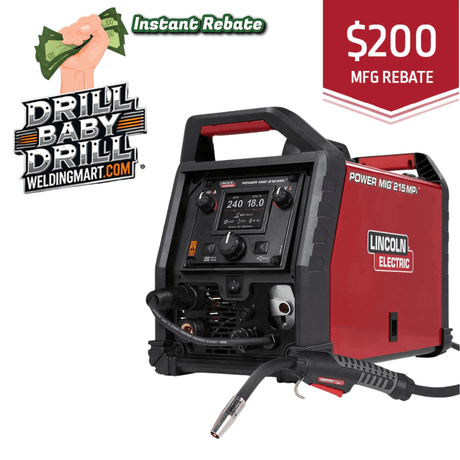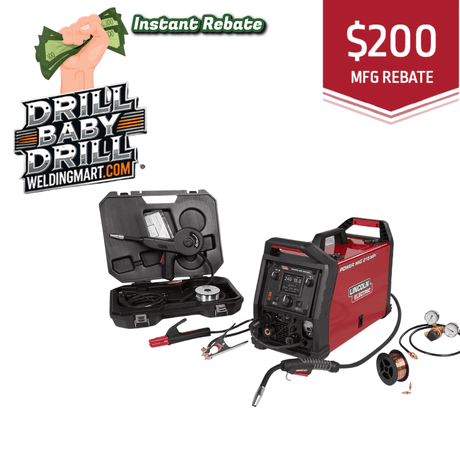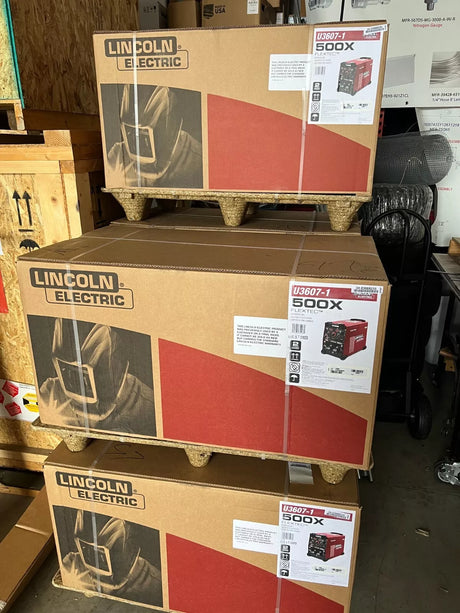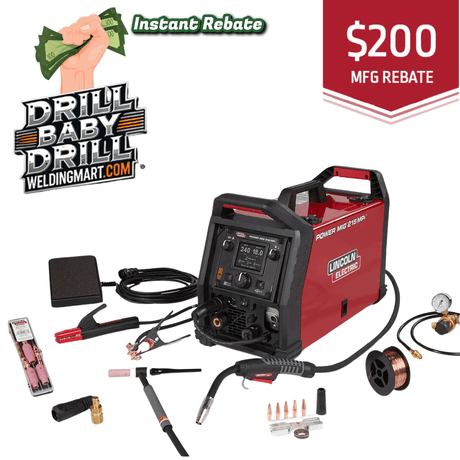Shop multi-process, MIG, TIG, and Stick welders built for versatility, precision, and durability. Perfect for automotive, fabrication, and repair work, these machines deliver multiple welding capabilities in one unit—saving time, space, and cost for professionals and DIY users alike.
-
Lincoln Power MIG 215 MPi Welder - Factory Demo - U4876-1
$1,949.00$2,249.99Unit price /UnavailableLincoln Power MIG 140 MP Multi-Process Welder TIG One-Pak Welding Package - K4499-1
$1,679.99Unit price /UnavailableLincoln Flextec 650X Multi-Process Welder with CrossLinc Technology - K3425-1
$9,477.25$10,507.00Unit price /UnavailableLincoln Power MIG 360MP Multi-Process Versatile Industrial Welder - K4467-1
$9,099.99Unit price /UnavailableLincoln Power MIG 215 MPi Multi-Process Welder Aluminum One-Pak - K4877-1
$2,699.99Unit price /UnavailableLincoln Flextec 500X Multi-Process Low Hour Factory Demo Welder - U3607-1
$6,199.00$7,799.00Unit price /UnavailableLincoln Power MIG 215 MPi Multi-Process Welder TIG One-Pak - K4878-1
$3,369.99Unit price /UnavailableLincoln Factory Low Hour Demo Flextec 350X Power Connect U4273-1
$6,299.00$8,133.00Unit price /UnavailableLincoln Power MIG 360MP Multi-Process Welder Education One-Pak - K4778-1
$9,909.99Unit price /UnavailableLincoln Flextec 650X Multi-Process Welder with CrossLinc / LF-74 HD One-Pak - K3513-1
$16,359.00$18,136.00Unit price /UnavailableLincoln Flextec 650X Multi-Process Welder with CrossLinc / LF-74 Ready-Pak - K3512-1
$15,241.20$16,897.00Unit price /UnavailableLincoln Idealarc DC600 with VRD Multi-Process Welder - K1288-28
$12,328.59$14,009.00Unit price /UnavailableLincoln Idealarc DC600 220/380/440 3/50/60 (Not Available in US) - K1365-23
$13,555.80Unit price /UnavailableLincoln Power MIG 360MP Aluminum Front Trigger One-Pak - K4784-1
$13,409.99Unit price /UnavailableLincoln Power Wave 300C Advanced Educational One-Pak K4934-1
$15,974.10$17,749.00Unit price /UnavailableLincoln Electric Welder Power Mig 210 MP Multi-Process Factory Demo Welder U3963-1
$2,049.00$2,099.00Unit price /UnavailableThe Ultimate Guide to Multi-Process, MIG, Stick, and TIG Welders
Introduction to Welding Techniques and Their Applications in Various Industries
Overview of MIG, TIG, Stick, and Multi-Process Welding Offerings
When it comes to metal fabrication and repair, choosing the right welding process is vital for efficiency, quality, and safety. The most widespread methods comprise MIG (Metal Inert Gas), TIG (Tungsten Inert Gas), and the versatile multi-process welder, which encompasses several welding functions into a single design.
- MIG Welding: Known for its ease of use, MIG welding uses a continuously fed wire and shielding gas to join metals.
- It's good for beginners and is widely used in automotive and construction fields.
- MIG welders offer a reliable method to work with thick materials due to their strong weld joint formation capabilities.
- TIG Welding: This process uses a tungsten electrode and requires greater skill, but offers higher precision and cleaner welds, particularly on aluminum or thin steel materials.
- Multi-Process Welders: These machines combine MIG, TIG, Stick (SMAW), and sometimes Plasma welding capabilities, offering flexibility for various project requirements and improving output.
- The combination of these features allows the welding machine to handle tasks ranging from basic repairs to advanced metal fabrication.
- In addition, some models provide integrated Plasma Cutters for precise metal cutting tasks.
Importance of Choosing the Right Welder
Selecting the ideal welder can impact productivity and the quality of your work. Factors such as the materials you commonly work with like steel or aluminum, your experience level, and the types of projects you tackle should all influence your decision. Multi-process welders appeal to those looking to invest in a practical machine for both DIY and professional projects, providing multiple welding, cutting, and support options without the need for multiple products.
Key Features of Multi-Process Welders
Versatility in Welding Techniques and Cutting
Multi-process welders excel due to their ability to switch between different welding techniques and cutting methods, making them an invaluable tool for any fabrication or repair shop. With a single piece of equipment, you can perform:
- MIG welding for its speed and ease, TIG welding for detailed, clean seams on delicate materials like aluminum, Stick welding for outdoor or heavy-duty work with various electrode types,
This versatility makes them ideal for workshops, small businesses, or anyone requiring flexibility in welding and cutting applications.
Cost-Effectiveness and Convenient Features
A multi-process welder represents a smart investment, especially if you consistently work on diverse welding and cutting projects. Owning a multiprocess welder reduces the need to purchase and store several different machines, while also simplifying the learning process for beginners. This not only saves money but also space. Many models allow seamless switching between modes and come with user-friendly controls, helping welders of all experience levels learn efficient techniques.
Comparing MIG and TIG Welding Techniques
Pros and Cons of Each Method
MIG Welding: - Pros: Faster, easier for beginners, ideal for aluminum and thick materials, and long welds. - Cons: Less precise than TIG welding, requires gas shielding, and may produce more splatter.
TIG Welding: - Pros: Extremely precise, produces clean and attractive welds on thin materials like aluminum or steel and offers great control over the welding process. - Cons: Slower process, more difficult to master, may require specialist equipment.
Best Applications for Each Technique
- MIG Welding: Suitable for automotive repairs, thick metalwork, fabrication tasks, and projects needing speed and efficiency.
- TIG Welding: Best for applications requiring a high-quality finish, such as bicycle frames, pipelines, or intricate designs with aluminum or thin steel.
Safety Considerations in Welding
Essential Protective Gear for Safe Welding
Safety should always be the foremost consideration in welding processes. All welders should use: - Auto-darkening welding helmet - Flame-resistant clothing and welding gloves - Respirator or adequate ventilation (especially for indoor projects) - Stick welding, for example, requires specific protective measures due to the intense heat produced. Safety boots with steel toes and good grip - Ear protection (when grinding or working in loud environments)
Best Practices for Safe Operation
- Always inspect equipment before use for damage or wear.
- Additionally, always ensure the welding machines, including stick welders, are set correctly to avoid accidents and ensure smooth operation.
- Proper setting adjustments, like deterring the amperage or electrode type, are crucial for achieving high-quality welds.
- Maintain a tidy workspace free of flammable materials, ensuring incident-free fabrication, especially when using stick welding.
- Ensure proper ventilation to avoid inhaling toxic fumes.
- Arc welding can be particularly dangerous without proper safety precautions.
- Always use suitable clamps to secure materials before starting the welding process with any Multi Process Welder.
- Follow the manufacturers instructions for each welder model, including Digital models offering advanced control.
- Never work alone when handling high-powered electrical equipment.
Top Brands and Models of Welders
Brand Comparisons and Cutting Performance
Several brands excel in producing high-quality welding tools and systems: These brands manufacture a variety of machines capable of handling different welding processes and requirements.
- Lincoln Electric: Known for their durable arc welders, suitable for home workshops and professional use. Miller Electric: Offers advanced features and exceptional build quality, particularly in MIG and TIG machines.
- Offers reliable solutions for various welding needs in both MIG and stick welding processes.
- Great value for money, with user-friendly controls and reliable performance in both MIG and multi-process welders. ESAB: Innovative, versatile machines suitable for experienced welders seeking multi-functionality.
- Their plasma cutters provide superior cutting performance, making them highly sought after by professionals.
Recommendations for Different Needs
- Best for Versatility: Lincoln Electric POWER MIG Multi-Process models
- Best for Beginners: Hobart Handler MIG welders
- Top for Professionals: Miller Multimatic series
- Budget Option: Forney Easy Weld Series
When choosing a welder, consider: - What materials and thicknesses you’ll be working with - The types of welding you’ll do most often - Portability and available workspace - Your experience and learning curve
Multi-process and combination MIG/TIG welders offer great value and efficiency for both new and experienced welders, making them a smart investment for any shop or garage. Additionally, investing in a reliable stick welder ensures strong welds even on thicker and more robust materials.
Lincoln Multi-Process Welders Questions & Answers



















